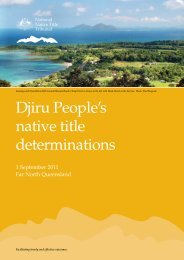Biodiveristy_State of Environment report - Mission Beach Cassowaries
Biodiveristy_State of Environment report - Mission Beach Cassowaries
Biodiveristy_State of Environment report - Mission Beach Cassowaries
- No tags were found...
Create successful ePaper yourself
Turn your PDF publications into a flip-book with our unique Google optimized e-Paper software.
2.1.1 Representation andRestorationPressureLand clearing is still occurring acrossall habitat types on land <strong>of</strong> more gentletopography. The rate is negligiblecompared to the original deforestation<strong>of</strong> the Shire for agriculture and timber.Table 2.1.1a describes land-clearingrates since 1995. Land clearing hascontinued to slow over the last twelveyears. Whilst clearing for crops hasslowed, there is a slight increase inclearing for cattle pasture. Nativevegetation covers 62.06% <strong>of</strong> the Shire. This is becauselarge areas are under protection by the WHA, which has anarea <strong>of</strong> 47% <strong>of</strong> the Shire. Approximately 15% <strong>of</strong> nativevegetation exists outside the WHA on private land; the rest(38%) has been cleared. Compared to other areas inQueensland these figures are very good. However, thereare problems with the representation <strong>of</strong> some endangeredecosystems.Isolation, Fragmentation and ConnectivityThe figures in the Table 2.1.1a do not detail the furthereffects associated with land clearing - isolation,fragmentation, and connectivity.The isolation <strong>of</strong> islands <strong>of</strong> vegetation amongst cleared landlimits the movement <strong>of</strong> many flora and fauna betweenareas <strong>of</strong> remnant vegetation. These species are then subjectto pressure from inbreeding, and where localised 'disasters'occur there are no new colonists to replace a lost species.This further affects other species 'on the island' when a lostspecies was an important part <strong>of</strong> the ecosystem.Fragmentation is similarly associated with land clearing.Fragmented vegetation results where in-roads have beenmade into what used to be a consistent area, resulting in amosaic <strong>of</strong> vegetation, much like the strands and patchesholding together a very worn piece <strong>of</strong> cloth. Fragmentationenhances the 'edge effect' on remnant vegetation. Edgeeffect describes the vulnerability <strong>of</strong> vegetation to externalinfluences. Some <strong>of</strong> these influences include; weedinvasion, cyclone damage and effects from the adjacentland use. Edge effect is worst where the remnantvegetation has a small area with a long boundary, i.e.where it is thin and spidery as opposed to fat and solid.Connectivity describes how well the remaining vegetationis linked. Connectivity problems are common in thefoothills west <strong>of</strong> Innisfail where topography has limitedland clearing to the flatter areas that are more suitable foragriculture; leaving many <strong>of</strong> the steep ridges, deep gulliesand rocky areas vegetated. Connectivity affects flora andfauna when large areas <strong>of</strong> cleared land exist, which speciesare unable to bridge in order to colonise or utilise nearbyareas. A lack <strong>of</strong> connectivity has resulted from landclearing, most obvious in separating the coastal ecosystemsfrom the range. Low connectivity affects genetic exchangebetween fragmented ecosystems, and can form a barrier inlifecycle events such as the dispersal <strong>of</strong> progeny ormigration.ConditionRepresentation <strong>of</strong> Regional EcosystemsWhilst there are large areas <strong>of</strong> protected vegetation in theShire, there are also a large variety <strong>of</strong> ecosystem typespresent. Not all <strong>of</strong> these ecosystems are representedequally, and some are classified as endangered becausethere are only small areas left throughout the <strong>State</strong>.The EPA has classified native vegetation throughout the<strong>State</strong> into groups based upon the ecosystem's floristiccomposition, the underlying geology, and climate.The types <strong>of</strong> regional ecosystems and their conservationstatus are defined under the Queensland VegetationTable 2.1.1a - Land Clearing in the Shire Source: NR&M (2003)Total Area ~164,000 ha % Wooded vegetation cover 2001(WHA = 47%)Year New Pasture Crops Forest Mining InfrastructurewoodyregrowthSettlementTotalCleared% Woodedvegetation cover2001(WHA = 47%)01-03 nd 22 2 0 0 1 0 25 62.06 2 (15.06) 0.0099-01 0 15 8 0 0 2 0 25 62.41 (15.41) 0.004397-99 2 7 21 1 0 0 0 30 62.43 (15.43) 0.00795-97 5 7 86 0 0 0 3 96 62.49 (15.49) 0.02891-95 1 0 0 120 0 0 2 1 123 62.56 (15.56) 0.042nd – not determined1 Double time period2 Updated accuracy <strong>of</strong> satellite imagery also contributing to this revised figure% Totalclearing inQld27



